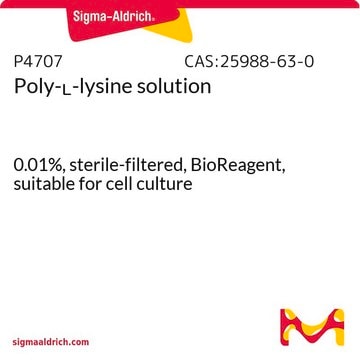Kluczowe dokumenty
P8203
PIPES
BioXtra, ≥99% (titration)
Synonim(y):
1,4-Piperazinediethanesulfonic acid, Piperazine-1,4-bis(2-ethanesulfonic acid), Piperazine-N,N′-bis(2-ethanesulfonic acid)
Wybierz wielkość
573,00 zł
Wybierz wielkość
About This Item
573,00 zł
Polecane produkty
linia produktu
BioXtra
Próba
≥99% (titration)
Formularz
powder
zanieczyszczenia
Insoluble matter, passes filter test
pozostałość po prażeniu (900°C)
≤0.5% (as SO4)
strata
≤0.5% loss on drying, 110°C
przydatny zakres pH
6.1-7.5
pKa (25°C)
6.8
mp
>300 °C (lit.)
rozpuszczalność
1 M NaOH: 0.5 M at 20 °C, clear, colorless
ślady anionów
chloride (Cl-): ≤0.2%
ślady kationów
Al: ≤0.005%
Ba: ≤0.0005%
Bi: ≤0.0005%
Ca: ≤0.005%
Cd: ≤0.0005%
Co: ≤0.0005%
Cr: ≤0.0005%
Cu: ≤0.0005%
Fe: ≤0.0005%
K: ≤0.005%
Li: ≤0.0005%
Mg: ≤0.0005%
Mn: ≤0.0005%
Mo: ≤0.0005%
Na: ≤0.1%
Ni: ≤0.0005%
Pb: ≤0.0005%
Sr: ≤0.0005%
Zn: ≤0.0005%
Absorpcja
≤0.1 at 260 in 1 M NaOH at 0.5 M
≤0.1 at 280 in 1 M NaOH at 0.5 M
Zastosowanie
diagnostic assay manufacturing
ciąg SMILES
OS(=O)(=O)CCN1CCN(CC1)CCS(O)(=O)=O
InChI
1S/C8H18N2O6S2/c11-17(12,13)7-5-9-1-2-10(4-3-9)6-8-18(14,15)16/h1-8H2,(H,11,12,13)(H,14,15,16)
Klucz InChI
IHPYMWDTONKSCO-UHFFFAOYSA-N
Szukasz podobnych produktów? Odwiedź Przewodnik dotyczący porównywania produktów
Powiązane kategorie
Opis ogólny
Zastosowanie
PIPES has been utilized in protein crystallization.[5],[6] The use of PIPES in the reconstitution of dissociated tubulin
α and β subunits after their resolution on immunoadsorbent gels has been described.[7] PIPES has been recommended for use in buffers for the in vitro study of caspases 3, 6, 7, and 8.[8]
A published study demonstrated the usefulness of PIPES as a non-metal ion complexing buffer in such applications as protein assays.[9] PIPES has been used in cell culture for such applications as the engineering of a thermostable mutant membrane protein in Escherichia coli.[10]
Powiązanie
Uwaga dotycząca przygotowania
Komentarz do analizy
Kod klasy składowania
13 - Non Combustible Solids
Klasa zagrożenia wodnego (WGK)
WGK 3
Temperatura zapłonu (°F)
Not applicable
Temperatura zapłonu (°C)
Not applicable
Środki ochrony indywidualnej
Eyeshields, Gloves, type N95 (US)
Wybierz jedną z najnowszych wersji:
Certyfikaty analizy (CoA)
Nie widzisz odpowiedniej wersji?
Jeśli potrzebujesz konkretnej wersji, możesz wyszukać konkretny certyfikat według numeru partii lub serii.
Masz już ten produkt?
Dokumenty związane z niedawno zakupionymi produktami zostały zamieszczone w Bibliotece dokumentów.
Klienci oglądali również te produkty
Protokoły
Cell staining can be divided into four steps: cell preparation, fixation, application of antibody, and evaluation.
TE Buffer; Elution Buffer; 10x Ligation Buffer; 0.5 M PIPES Buffer; Inoue Transformation Buffer
Active Filters
Nasz zespół naukowców ma doświadczenie we wszystkich obszarach badań, w tym w naukach przyrodniczych, materiałoznawstwie, syntezie chemicznej, chromatografii, analityce i wielu innych dziedzinach.
Skontaktuj się z zespołem ds. pomocy technicznej









